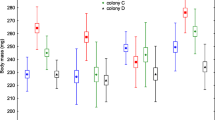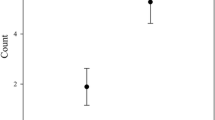Abstract
Honey bee workers maintain the brood nest of their colony within a narrow temperature range of 34.5±1.5°C, implying that there are significant fitness costs if brood is reared outside the normal range. However, the effects of abnormal incubation temperatures are subtle and not well documented. Here we show that short-term learning and memory abilities of adult workers are affected by the temperature they experienced during pupal development. In contrast, long-term learning and memory is not significantly affected by rearing temperature. Furthermore, we could detect no effects of incubation temperature on fluctuating asymmetry, as a measure of developmental stability, in workers, queens or drones. We conclude that the most important consequence of abnormal rearing temperatures are subtle neural deficiencies affecting short-term memory rather than physical abnormalities.


Similar content being viewed by others
Abbreviations
- FA:
-
Fluctuating asymmetry
- FDR:
-
False discovery rate
- LT:
-
Long-term
- PER:
-
Proboscis extension reflex
- ST:
-
Short-term
References
Bitterman ME, Menzel R, Fietz A, Schafer S (1983) Classical conditioning of the proboscis extension in honey bees (Apis mellifera). J Comp Psychol 97:107–119
Bjorksten TA, Pomianowski A, Fowler K (2001) Temperature shock during development fails to increase the fluctuating asymmetry of a sexual trait in stalk-eyed flies. Proc R Soc Lond B 268:1503–1510
Brandes CH, Frisch B, Menzel R (1988) Time-course memory formation differs in honey bee lines selected for good and poor learning. Anim Behav 36:981–985
Clarke GM (1997) The genetic basis of developmental stability. III. Haplodiploidy: are males more unstable than females? Evolution 51:2021–2028
Clarke GM (1998) The genetic basis of develomental stability. IV. Individual and population asymmetry parameters. Heredity 80:553–561
Clarke GM, McKenzie LJ (1992) Fluctuating asymmetry as a quality control indicator for insect mass rearing processes. J Econ Entomol 85:2045–2050
Clarke GM, Oldroyd BP, Hunt P (1992) The genetic basis of developmental stability in Apis mellifera: heterozygosity versus genic balance. Evolution 46:753–762
Farris SM, Robinson GE, Davis RL, Fahrbach SE (1999) Larval and pupal development of the mushroom bodies in the honey bee, Apis mellifera. J Comp Neurol 414:97–113. DOI 10.1002/(SICI)1096-9861(19991108)414:1<97::AID-CNE8>3.0.CO;2-Q
Garcia LV (2003) Controlling the false dicovery rate in ecological research. TREE 18:553–554. DOI 10.1016/j.tree.2003.08.008
Garcia LV (2004) Escaping the bonferroni iron claw in ecological studies. Oikos 105:657–663. DOI 10.1111/j.0030-1299.2004.13046.x
Gauthier M, Belzunces LP, Zaoujal A, Colin ME, Richard D (1992) Modulatory effect of learning and memory on honey bee brain acetylcholinesterase activity. Comp Biochem Physiol 103:91–95
Gerber B, Gerberzahn N, Hellstern F, Klein J, Kowalsky O, Wustenberg D, Menzel R (1996) Honey bees transfer olfactory memories established during flower visits to a proboscis extension paradigm in the laboratory. Anim Behav 52:1079–1085. DOI 10.1006/anbe.1996.0255
Gramacho KP, Spivak M (2003) Differences in olfactory sensitivity and behavioural responses among honey bees bred for hygienic behavior. Behav Ecol Sociobiol 54:472–479. DOI 10.1007/s00265-003-0643-y
Groh C, Tautz J, Rossler W (2004) Synaptic organization in the adult honey bee brain is influenced by brood-temperature control during pupal development. Proc Natl Acad Sci USA 101:4268–4273. DOI 10.1073/pnas.0400773101
Hammer M, Menzel R (1995) Learning and memory in the honeybee. J Neurosci 15:1617–1630
Hammer M, Menzel R (1998) Multiple sites of associative odor learning as revealed by local brain microinjections of octopamine in honeybees. Learn Mem 5:146–156
Harbo JR (1986) Propagation and instrumental insemination. In: Rinderer TE (ed) Bee genetics and breeding. Academic Press, Orlando
Hogg ID, Eadie JM, Williams DD, Turner D (2001) Evaluating fluctuating asymmetry in a stream-dwelling insect as an indicator of low-level thermal stress: a large-scale field experiment. J App Ecol 38:1326–1339. DOI 10.1046/j.0021-901.2001.00682.x
Imasheva AG, Loeschcke V, Zhivotovsky LA, Lazebny OE (1997) Effects of extreme temperature on phenotypic variation and developmental stability in Drosophila melanogaster and Drosophila buzzatii. Biol J Linn Soc 61:117–126
Jones JC, Myerscough MR, Graham S, Oldroyd BP (2004) Honey bee nest thermoregulation: diversity promotes stability. Science 305:402–404. DOI 10.1126/science.1096340
Kleinhenz M, Bujok B, Fuchs S, Tautz J (2003) Hot bees in empty broodnest cells: heating from within. J Exp Biol 206:4217–4231
Korb J, Linsenmair K (1998) The effects of temperature on the architecture and distribution of Macrotermes bellicosus (Isoptera, Macroterminae) mounds in different habitats of a West African Guinea savanna. Insectes Sociaux 45:51–65. DOI 10.1007/s000400050068
Korb J, Linsenmair K (1999) The architecture of termite mounds: a result of a trade-off between thermoregulation and gas exchange? Behav Ecol 10:312–316
Kronenberg F, Heller HC (1982) Colonial thermoregulation in honey bees (Apis mellifera). J Comp Physiol B 148:65–76
Laloi D, Gallois M, Roger B, Pham-Delegue M (2001) Changes with age in olfactory conditioning performance of worker honey bees (Apis mellifera). Apidologie 32:231–242. DOI 10.1051/apido:2001125
Leary RF, Allendorf FW (1989) Fluctuating asymmetry as an indicator of stress: implications for conservation biology. TREE 4:214–217
Leung B, Forbes MR, Houle D (2000) Fluctuating asymmetry as a bioindicator of stress: comparing efficacy of analyses involving multiple traits. Am Nat 155:101–115
Maleszka R, Helliwell P (2001) Effect of juvenile hormone on short-term olfactory memory in young honeybees (Apis mellifera). Horm Behav 40:403–408. DOI 10.1006/hbeh.2001.1705
Maleszka R, Helliwell P, Kucharski R (2000) Pharmacological interference with glutamate re-uptake impairs memory in the honeybee, Apis mellifera. Behav Brain Res 115:49–53. DOI 10.1016/s0166-4328(00)00235-7
Matheson A (1984) Practical beekeeping in New Zealand. P.D. Hasselberg, Government Printer, Wellington
McKenzie JA, Yen JL (1995) Genotype, environment and the asymmetry phenotype. Dieldrin-resistance in Lucilia cuprina (the Australian sheep blowfly). Heredity 75:181–187
McMullan JB, Brown MJF (2005) Brood pupation temperature affects the susceptibility of honeybees (Apis mellifera) to infestation by tracheal mites (Acarapis woodi). Apidologie 36:97–105. DOI 10.1051/apid:2004073
Menzel R (1993) Associative learning in honey bees. Apidologie 24:157–168
Menzel R (1999) Memory dynamics in the honeybee. J Comp Physiol A 185:323–340
Morgan SM, Butz Huryn VM, Downes SR, Mercer AR (1998) The effects of queenlessness on the maturation of the honey bee olfactory system. Behav Brain Res 91:115–126. DOI 10.1016/s0166-4328(97)00118-6
Mpho M, Holloway G, Callaghan A (2001) A comparison of the effects of organophosphate insecticide exposure and temperature stresson fluctuating asymmetry and life history traits in Culex quinquefasciatus. Chemosphere 45:713–720. DOI 10.1016/s0045-6535(01)00140-0
Müller U (1996) Inhibition of nitric oxide synthase impairs a distinct form of long-term memory in the honeybee, Apis mellifera. Neuron 16:541–549. DOI 10.1016/s0896-6273(00)80073-2
Palmer AR (1994) Fluctuating asymmetry analyses: a primer. In: Markow TA (eds) Developmental instability: its origins and evolutionary implications. Kluwer, Dordrecht, pp 335–364
Palmer AR, Strobeck C (2003) Fluctuating asymmetry analyses revisited. In: Polak M (eds) Developmental instability causes and consequences. Oxford University Press, New York, pp 279–319
Pascual A, Preat T (2001) Localization of long-term memory within the Drosophila mushroom body. Science 294:1115–1117. DOI 10.1126/science.1064200
Phillips EF (1929) Variation and correlation in the appendages of the honeybee. Cornell Ag Expt Stn Memoir 121
Ray S, Ferneyhough B (1999) Behavioral development and olfactory learning in the honeybee (Apis mellifera). Dev Psychobiol 34:21–27. DOI 10.1002/(SICI)1098-2302(199901)34:1<5::AID-DEV3>3.0.CO;2-F
Schneider SS, Leamy LJ, Lewis LA, DeGrandi-Hoffman G (2003) The influence of hybridization between African and European honeybees, Apis mellifera, on asymmetries in wing size and shape. Evolution 57:2350–2364. DOI 10.1043/0014-3820(2003)057(2350:TIOHBA)2.0CO;2
Seeley TD, Heinrich B (1981) Regulation of temperature in the nests of social insects. In: Heinrich B (eds) Insect thermoregulation. Wiley, New York, pp 159–234
Simpson J (1961) Nest climate regulation in honey bee colonies. Science 133:1327–1333
Smith DR, Crespi BJ, Bookstein FL (1997) Fluctuating asymmetry in the honey bee, Apis mellifera: effects of ploidy and hybridization. J Evol Biol 10:551–574
Storey JD, Tibshirani R (2003) Statistical significance for genomewide studies. Proc Natl Acad Sci USA 100:9440–9445. DOI 10.1073/pnas.1530509100
Strausfeld NJ (2002) Organization of the honey bee mushroom body: representation of the calyx within the vertical and gamma lobes. J Comp Neurol 450:4–33. DOI 10.1002/cne.10285
Tautz J, Maier S, Groh C, Rossler W, Brockmann A (2003) Behavioural performance in adult honey bees is influenced by the temperature experienced during their pupal development. Proc Natl Acad Sci USA 100:7343–7347
Verhoeven KJF, Simonsen KL, McIntyre LM (2005) Implementing false discovery rate control: increasing your power. Oikos 108:643–647
Von Frisch K (1993) The dance language and orientation of bees. Harvard University Press, Cambridge
Winston ML (1987) The biology of the honey bee. Harvard University Press, Cambridge
Woods RE, Sgro CM, Hercus MJ, Hoffmann AA (1999) The association between fluctuating asymmetry, trait variability, trait heritability and stress: a multiply replicated experiment on combined stresses in Drosophila melanogaster. Evolution 53:493–505
Zars T, Fischer M, Schultz R, Heisenberg M (2000) Localization of a short-term memory in Drosophila. Science 288:672–675. DOI 10.1126/science.288.5466.672
Acknowledgements
We thank Michael Duncan for his help with bee-keeping. This research was funded by an ARC grant to B. P. Oldroyd and R. H. Crozier. Our experiments comply with the “Principles of animal care”, publication No. 86–23, revised 1985 of the National Institute of Health, and also with the current laws of Australia where the experiments were performed.
Author information
Authors and Affiliations
Corresponding author
Rights and permissions
About this article
Cite this article
Jones, J.C., Helliwell, P., Beekman, M. et al. The effects of rearing temperature on developmental stability and learning and memory in the honey bee, Apis mellifera . J Comp Physiol A 191, 1121–1129 (2005). https://doi.org/10.1007/s00359-005-0035-z
Received:
Revised:
Accepted:
Published:
Issue Date:
DOI: https://doi.org/10.1007/s00359-005-0035-z




